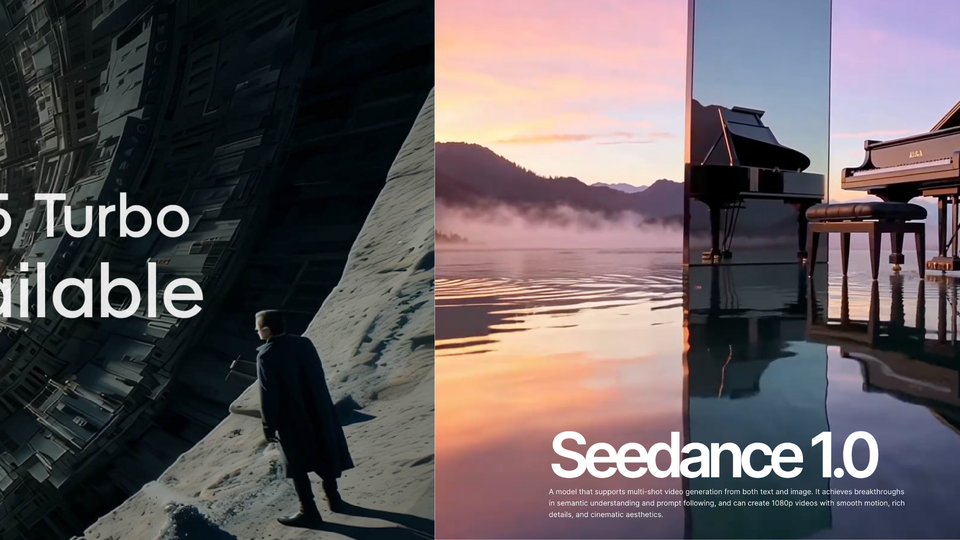Seedance 1.0 vs Kling 2.5 Turbo: Which AI Video Generator Should You Choose?

The AI video generation space has two clear frontrunners right now, and they couldn't be more different in their approach. Seedance 1.0 from ByteDance focuses on storytelling and multi-shot cinematography, while Kling 2.5 Turbo doubles down on realism and action sequences. Both are impressive, but they serve different needs.
If you're trying to decide between them, the choice comes down to what kind of content you create and what matters most to your workflow. Let's break down how these two models stack up against each other.
The Core Philosophy Difference
Seedance 1.0 treats video generation like filmmaking. It understands that good video content isn't just moving pictures—it's about shots, angles, and visual storytelling. When you give it a prompt, it thinks like an editor, creating multiple shots that work together to tell a story.
Kling 2.5 Turbo approaches video generation like a physics simulation. It wants to create the most realistic, believable motion possible. Every movement, every camera shake, every character action is designed to look like it could exist in the real world.
Feature Comparison
| Aspect | Seedance 1.0 | Kling 2.5 Turbo |
|---|---|---|
| Signature Feature | Multi-shot generation | Enhanced motion physics |
| Best For | Storytelling and narrative content | Action sequences and realistic motion |
| Video Quality | 1080p with cinematic feel | High-resolution with photorealistic output |
| Processing Speed | Under 1 minute on good hardware | Optimized for faster generation |
| Prompt Handling | Excellent for narrative descriptions | Superior with complex, detailed prompts |
| Camera Work | Multiple angles and shots automatically | Dynamic camera movements and effects |
When to Choose Seedance 1.0
Pick Seedance if you're creating content that needs to tell a story. The multi-shot capability makes it perfect for:
Social media storytelling where you need to hook viewers with a narrative arc. Instead of one static shot, you get establishing shots, close-ups, and different angles that keep people watching.
Marketing videos that need to explain a product or service. The ability to show wide shots of context, then zoom in on details, then cut to user reactions—all from one prompt—is genuinely useful.
Creative projects where the visual flow matters more than photorealism. If you're making content where the story is more important than whether every shadow looks perfect, Seedance excels.
Quick prototyping for larger video projects. Directors and producers can test narrative ideas quickly before committing to full production.
When to Choose Kling 2.5 Turbo
Go with Kling 2.5 Turbo when realism and action are your priorities:
Action content where movement and physics matter. Car chases, sports sequences, dance videos—anything where the motion needs to look believable benefits from Kling's physics understanding.
Professional presentations where you need content that looks like it could be real footage. The enhanced realism makes it harder for viewers to immediately identify content as AI-generated.
Complex scene generation with multiple moving elements. Kling handles busy, complicated prompts better than most other tools.
High-end marketing where production value matters more than storytelling structure. If you need something that looks expensive, Kling delivers.
The Practical Reality
Both tools have limitations. Seedance's multi-shot feature works best when you're specific about what shots you want. Vague prompts still produce mediocre results. Kling's realism is impressive, but it can struggle with more abstract or stylized content.
Neither tool is perfect for every use case. Seedance sometimes produces shots that don't flow well together. Kling occasionally creates motion that's technically correct but feels unnatural. Both can produce artifacts or miss details in complex prompts.
Pricing and Access
Both models are available through multiple platforms, with pricing that varies depending on where you access them. Seedance is available through ByteDance's Seed platform and various third-party integrations. Kling 2.5 Turbo can be accessed through the official Kling AI platform and several partner services.
The cost per generation is generally comparable between the two, though Kling 2.5 Turbo's speed optimizations can make it more cost-effective for high-volume use.
The Bottom Line
This isn't really a competition—it's two different tools for different jobs. Seedance 1.0 is for creators who think like directors and want to tell stories. Kling 2.5 Turbo is for creators who need realistic motion and don't mind handling the editing themselves.
The best approach might be having access to both. Use Seedance when you need narrative structure and multiple shots. Use Kling when you need realistic action or complex motion. As AI video tools continue to improve, having the right tool for each job becomes more important than finding one tool that does everything.
Both represent significant steps forward in AI video generation. The fact that we're now choosing between "great storytelling" and "incredible realism" instead of just hoping for something usable shows how far this technology has come.
